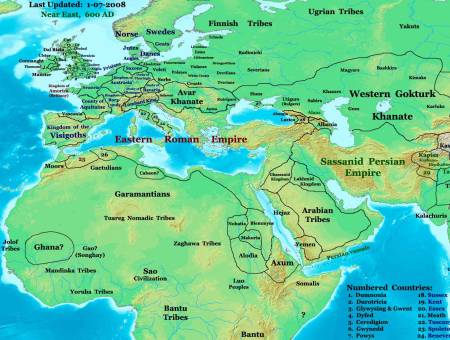Table of Contents
<html>
<a href=“http://lucianofsamosata.info/wiki/doku.php?id=submission_page”><img src=“http://lucianofsamosata.info/images/contact.png” /></a>
</html>
Discovery of the Garamantes: Lucian's Text
<html><p xmlns:dct=“http://purl.org/dc/terms/”><a rel=“license” href=“http://creativecommons.org/publicdomain/mark/1.0/”><img src=“http://i.creativecommons.org/p/mark/1.0/88x31.png” style=“border-style: none;” alt=“Public Domain Mark” /></a><br />This work (by <a href=“https://lucianofsamosata.info/wiki” rel=“dct:creator”>https://lucianofsamosata.info/wiki</a>), identified by <a href=“http://meninpublishing.org” rel=“dct:publisher”><span property=“dct:title”>Frank Redmond</span></a>, is free of known copyright restrictions.</p></html>
Authored by Frank Redmond, 2011
With the demise of the Ghaddafi regime in Libya, the floodgates have been opened for archeologists to study the Garamantes, an ancient Berber kingdom that populated that region from 500 BC to 700 AD Garamantes. In the archeology world, it's like going to explore El-Dorado except that the archeologists always knew that the remnants of Garamantian civilization was always there but they were never able to be physically there to dig and conduct tests, at least not for the last 40 years. Check out this good preview article: Satellite Photos Show Ancient Saharan Fortresses of a Lost Empire
It is well-known that Herodotus and some other ancient authors like Pliny the Elder mentioned the Garamantes, but it is less well-known that Lucian also wrote about the Garamantes in his essay Dipsas, the Thirst Snake. Although the essay was probably written as a rhetorical exercise, it provides a vivid picture the utter desolation of the Sahara Desert and the tribulations of the Garamantians. It is clear that Lucian does not romanticize the lifestyle of the Garamantes. I advise you to read the entire essay for its wonderful use of imagery and juxtaposition, but here is an excerpt from Lucian's text:
<html> <div style=“border: 2px solid silver; color: darkblue; padding: 10px;”> On its borders dwell the Garamantians, a lightly clad, agile tribe of tent-dwellers subsisting mainly by the chase. These are the only people who occasionally penetrate the desert, in pursuit of game. They wait till rain falls, about the winter solstice, mitigating the excessive heat, moistening the sand, and making it just passable. Their quarry consists chiefly of wild asses, the giant ostrich that runs instead of flying, and monkeys, to which the elephant is sometimes added; these are the only creatures sufficiently proof against thirst and capable of bearing that incessant fiery sunshine. But the Garamantians, as soon as they have consumed the provisions they brought with them, instantly hurry back, in fear of the sand's recovering its heat and becoming difficult or impassable, in which case they would be trapped, and lose their lives as well as their game. For if the sun draws up the vapour, dries the ground rapidly, and has an access of heat, throwing into its rays the fresh vigour derived from that moisture which is its aliment, there is then no escape. </div> </html>
And here is how Lucian describes Libya:
<html> <div style=“border: 2px solid silver; color: darkblue; padding: 10px;”> THE southern parts of Libya are all deep sand and parched soil, a desert of wide extent that produces nothing, one vast plain destitute of grass, herb, vegetation, and water; or if a remnant of the scanty rain stands here and there in a hollow place, it is turbid and evil-smelling, undrinkable even in the extremity of thirst. The land is consequently uninhabited; savage, dried up, barren, droughty, how should it support life? The mere temperature, an atmosphere that is rather fire than air, and a haze of burning sand, make the district quite inaccessible. </div> </html>
Read the rest HERE.
I think it will be a nice contrast to read what Herodotus has to say about the Garamantes. Some of it is ridiculous, but that's what makes Herodotus so charming 
<html> <div style=“border: 2px solid silver; color: darkblue; padding: 10px;”> Ten days' journey from Augila there is again a salt-hill and a spring; palms of the fruitful kind grow here abundantly, as they do also at the other salt-hills. This region is inhabited by a nation called the Garamantians, a very powerful people, who cover the salt with mould, and then sow their crops. From thence is the shortest road to the Lutophagi, a journey of thirty days. In the Garamantian country are found the oxen which, as they graze, walk backwards. This they do because their horns curve outwards in front of their heads, so that it is not possible for them when grazing to move forwards, since in that case their horns would become fixed in the ground. Only herein do they differ from other oxen, and further in the thickness and hardness of their hides. The Garamantians have four-horse chariots, in which they chase the Troglodyte Ethiopians, who of all the nations whereof any account has reached our ears are by far the swiftest of foot. The Troglodytes feed on serpents, lizards, and other similar reptiles. Their language is unlike that of any other people; it sounds like the screeching of bats. </div> </html>
